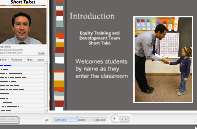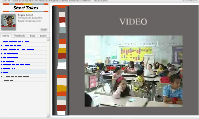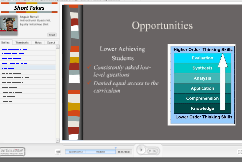 MONTGOMERY COUNTY PUBLIC SCHOOLS
MONTGOMERY COUNTY PUBLIC SCHOOLS
 MONTGOMERY COUNTY PUBLIC SCHOOLS
MONTGOMERY COUNTY PUBLIC SCHOOLS
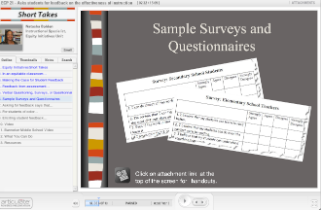 ECP 21: Asks students for feedback on the effectiveness of instruction
ECP 21: Asks students for feedback on the effectiveness of instruction“Student feedback is an important source of information for teachers. When teachers solicit and use student feedback, they can alter and improve their teaching. Individual discussion with students who are having trouble can help teachers adapt instruction to meet student needs. Adjustments may be made by adapting materials, varying cues, changing the sequence of instruction, adjusting timing and transitions from one activity to another, or developing more appropriate expectations (Weinstein, 1983).”
Bellon, J. J., Bellon, Elner C, & Blank, Mary Ann. (1992). Teaching from a research knowledge base: A development and renewal process. New York: Merrill. p. 62.
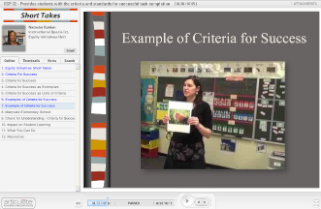 ECP 22: Provides students with the criteria and standards for successful task completion
ECP 22: Provides students with the criteria and standards for successful task completion“Chappuis and Stiggins and others cite a particularly effective method to communicate to students the criteria for success of a learning goal: the provision of exemplars, ‘anonymous samples of strong student performances.’ By examining a variety of these successful products, particularly when this activity is done collaboratively with peers and with teacher guidance, students can begin to determine the attributes of quality by discerning patterns and formulating generalizations of the critical attributes of the learning goal. They also define what evidence of learning looks like. They begin to create a mental model of what success looks like in terms of the learning goal or standard. . . . that this is especially important for students who struggle the most.”
Equity Training and Development Team. (2006). Providing students with effective feedback: Communicating the goal. Retrieved November 2008, from MCPS website: https://www.montgomeryschoolsmd.org/departments/development/teams/diversity/diversity.shtm
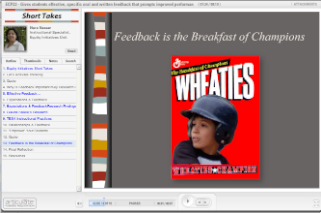 ECP 23: Gives students effective, specific oral and written feedback that prompts improved performance
ECP 23: Gives students effective, specific oral and written feedback that prompts improved performance“Immediate feedback helps students begin to ask relevant questions about the work, make decisions, and learn to evaluate the writing while working on it rather than after they have completed the writing and given it to the teacher for grading. While students are engaged in various stages of the writing process, teachers free themselves to conference individually with students and to work with small groups. And while the teacher is thus engaged, students must be able to help each other. Hence, each student must have an understanding of how to help peers develop and revise text.”
Cole, R. W. (ed.). (1995). Educating everybody’s children: Diverse teaching strategies for diverse learners. Alexandria, VA: ASCD. p. 108.
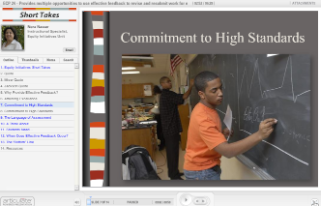 ECP 24: Provides multiple opportunities to use effective feedback to revise and resubmit work for evaluation against the standard
ECP 24: Provides multiple opportunities to use effective feedback to revise and resubmit work for evaluation against the standard“The re-teach and reassess policy creates an environment of learning that promotes effort and persistence. Giving students the opportunity to master a skill over time and with repeated attempts may change their ideas about how and why they succeed in class. If we offer our students the opportunity to try again and really work with them to achieve, perhaps their perceptions of the causes of achievement can change from an innate ability to perform to persistence and effort.”
Guthrie, J. (2007). Engaging adolescents in reading. Thousand Oaks, CA: Corwin Press. p. 29
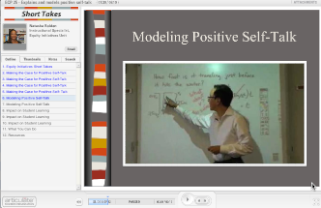 ECP 25: Explains and models positive self-talk
ECP 25: Explains and models positive self-talk“Meta-reflecting on your experience offers an interpretation of an entirely different kind. Meta-reflection is a “step back” interpretation of “how” you experience the “what” or content of the educational situation. The necessary stepping back from the experience while still participating in it allows us to gain insight about the meaning of patterns of behavior and experience. Creating the momentary space between yourself and your experience allows you to make deliberate, conscious choices about how you interpret classroom or familial interactions. Meta-reflection gives insights to patterns of your own interpretations of how students act, interact, or react and, ultimately, insights into how you might intervene. Others refer to this metaprocess as self-awareness or mindfulness (Goleman, 1996, 1998).”
Brown, J. H., D’Emidio-Caston, M., & Benard, B. (2001). Resilience education. Thousand Oaks, CA: Corwin Press. p. 77
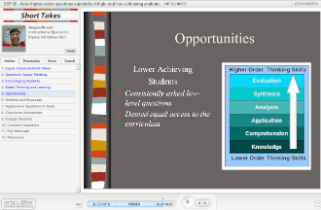 ECP 26: Asks higher-order questions equitably of high- and low-achieving students
ECP 26: Asks higher-order questions equitably of high- and low-achieving students“According to the research, many teachers are reluctant to include low achieving students in discussions that would encourage them to explain their ideas and stimulate their thinking. High achieving students are asked questions that require them to give greater detail or explanation, which strengthens their confidence in their thinking ability. If low achieving students are consistently asked low level questions, they are being denied equal access to the curriculum (Loftus, 1992). Low achieving students need opportunities to discover they are capable of good thinking and that it is EXPECTED of them by their teachers.”
Equity Training and Development Team. (2007). Fostering higher order thinking. Retrieved November 2008, from MCPS website: https://www.montgomeryschoolsmd.org/departments/development/teams/diversity/diversity.shtm
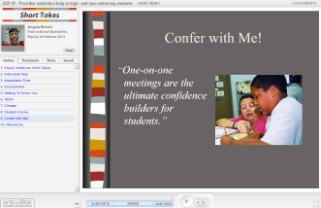 ECP 27: Provides individual help to high- and low-achieving students
ECP 27: Provides individual help to high- and low-achieving students“Mentoring is one means of giving students individual help. Even though mentoring is not always an activity conducted exclusively between teacher and student, there is merit in considering the benefits of mentors. . . . Mentors are actively involved in responding to students’ performances, offering assistance and outside resources, assessing obstacles and solutions. Bond (2000) studied the effects of mentoring on student achievement. His report discusses one-on-one tutoring, volunteer tutor schemes, peer tutoring as well as teacher-student mentoring. He promotes mentoring as a model for better learning environment because it focuses on the social and individual contexts of learning.”
Los Angeles County Office of Education. (2002). Teacher Expectations Student Achievement (TESA): A staff development program for all teachers, coordinators manual. Downy, CA: Los Angeles County Office of Education. p. D-13.
